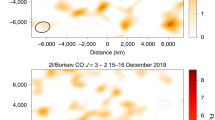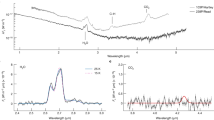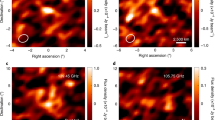Abstract
Our previous pre-perihelion observations1 of comet Halley from the NASA Kuiper Airborne Observatory (KAO) resulted in the first definite detection of water vapour in a comet. This success allowed us to carry out an ambitious post-perihelion KAO observing programme which significantly extended the scope of our Halley water investigation. The spectral bandwidth of the post-perihelion data included essentially all of the ν3 band. Fifteen spectral lines of water were detected, including three previously undetected lines in the ν3 band (A ≃ 2.65 μm) and three lines in the (011–010) band. The observed relative intensities illustrate that water in the cometary coma is rotationally relaxed, as predicted by recent nonthermal-equilibrium models2,3. An ortho/para ratio of ∼3 is consistent with both pre- and post-perihelion data. The water spatial brightness profile can be fit by that of a parent molecule, and a significant sunward-tailward brightness asymmetry was observed which suggests ejection primarily into the sunlit hemisphere. Comet Halley exhibited marked temporal activity on timescales as short as 2 h. The largest water production rate measured was 2.3 × 1030 mol s−1 on 24:18ut March 1986, which is about an order of magnitude (or more) larger than the production rates we measured pre-perihelion at the same heliocentrie distance (∼1 AU), indicating a large pre- to post-perihelion asymmetry in gas production.
This is a preview of subscription content, access via your institution
Access options
Subscribe to this journal
Receive 51 print issues and online access
$199.00 per year
only $3.90 per issue
Buy this article
- Purchase on Springer Link
- Instant access to full article PDF
Prices may be subject to local taxes which are calculated during checkout
Similar content being viewed by others
References
Mumma, M. J., Weaver, H. A., Larson, H. P., Davis, D. S. & Williams, M. Science 232, 1523–1528 (1986).
Weaver, H. A. & Mumma, M. J. . Astrophys. J. 276, 782–797 (1984).
Crovisier, J. Astr. Astrophys. 130, 361–372 (1984).
Davis, D. S., Larson, H. P., Williams, M., Michel, G. & Connes, P. Appl. Opt. 19, 4138–4155 (1980).
Larson, H. P., Davis, D. S., Mumma, M. J. & Weaver, H. A. Astrophys. J. (in the press).
Keller, H. U. et al. Nature 321, 320–326 (1986).
Huebner, W. F. & Carpenter, C. W. Los Alamos Sci. Lab. Rep.,. LA-8085-MS (1979).
Krankowsky, D. et al. Nature 321, 326–329 (1986).
Feldman, P. D. et al. in New Insights in Astrophysics, 8 years of UV Astronomy with IUE (ed. Rolf, E. J.) ESA Spec. Publ. 263 (1986).
Sekanina, Z. & Larson, S. M. Nature 321, 357–361 (1986).
Festou, M. C. et al. Nature 321, 361–363 (1986).
Camy-Peyret, C., Flaud, J. M., Guelachvili, G. & Amiot, C. Molec. Phys. 26, 825–855 (1973).
Author information
Authors and Affiliations
Rights and permissions
About this article
Cite this article
Weaver, H., Mumma, M., Larson, H. et al. Post-perihelion observations of water in comet Halley. Nature 324, 441–444 (1986). https://doi.org/10.1038/324441a0
Received:
Accepted:
Issue Date:
DOI: https://doi.org/10.1038/324441a0
This article is cited by
-
Reservoirs for Comets: Compositional Differences Based on Infrared Observations
Space Science Reviews (2008)
-
Comets
The Astronomy and Astrophysics Review (1993)
Comments
By submitting a comment you agree to abide by our Terms and Community Guidelines. If you find something abusive or that does not comply with our terms or guidelines please flag it as inappropriate.



